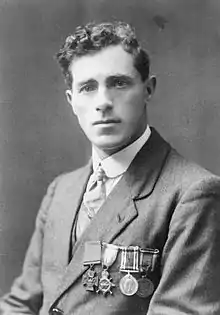Horace Augustus Curtis
Horace Augustus Curtis VC (7 March 1891 – 1 July 1968) was an English recipient of the Victoria Cross, the highest and most prestigious award for gallantry in the face of the enemy that can be awarded to British and Commonwealth forces.
Horace Augustus Curtis VC | |
|---|---|
 | |
| Born | 7 March 1891 St Anthony-in-Roseland, Cornwall |
| Died | 1 July 1968 (aged 77) Redruth, Cornwall |
| Allegiance | |
| Service/ | |
| Years of service | 1914 - 1923 |
| Rank | Company Sergeant Major |
| Unit | The Duke of Cornwall's Light Infantry The Royal Dublin Fusiliers |
| Battles/wars | World War I |
| Awards | |
Service
Between 1915 and 1918, Curtis served in three theatres of war: the Mediterranean Expeditionary Force, the Egyptian Expeditionary Force and finally the British Expeditionary Force (B. E. F) in France and Belgium.[1]
On 20 June 1918, Curtis returned to England, where he went to Bermondsley Military Hospital in London for treatment for malaria, broken by a furlough, home leave to Fiddlers Green between 24 July until 3 August, the first time in four years.[2]
He was finally cleared to return to his unit in France on 19 August and was back in France by 1 September and to the front by 21 September.[2]
VC action
On 18 October 1918, No. 14107 Sergeant Curtis, 2nd Battalion Royal Dublin Fusiliers fought in action near Le Cateau that earned him the Victoria Cross. The following is the official citation, which appeared in the London Gazette on 6 January 1919.
No.14107 Sjt. Horace Augustus Curtis.2nd Battalion, R. Dub. Fus (Newlyn East, Cornwall) For most conspicuous bravery and devotion to duty East of Le Cateau on the morning of 18th October 1918, when in attack his platoon came unexpectedly under intense machine-gun fire. Realising that the attack would fail unless the enemy guns were silenced, Sjt Curtis, without hesitation, rushed forward through our own barrage and the enemy fire and killed and wounded the teams of two of the guns, whereupon the remaining four guns surrendered. Then turning his attention to a train-load of reinforcements, he succeeded in capturing over 100 enemy before his comrades joined him. His valour and disregard of danger inspired all.[3]
His VC was presented to him by King George V at Buckingham Palace on 8 March 1919.[2]
Post war
Curtis was discharged on 31 March 1920. He joined the 5th (Territorial) Battalion DCLI on a 3-year engagement at St Columb on 5 May 1920. Private 5431368, he was rapidly promoted to Sergeant and by 27 August 1920 was WO2 (CSM). On 20 December 1921, he transferred to the 4/5th DCLI and on 19 May 1923 his service was terminated at the end of his engagement.[4]
Curtis, who became increasingly more ill during the 1960s, eventually becoming almost completely paralysed, died on 1 July 1968, at the age of seventy-seven.[4]
The Medal
His VC is on display in the Lord Ashcroft Collection[5] at the Imperial War Museum, London.
References
- Gliddon 2000, pp. 187–188.
- Gliddon 2000, p. 187.
- "No. 31108". The London Gazette (Supplement). 4 January 1919. p. 307.
- Gliddon 2000, p. 188.
- "Lord Ashcroft VC collection". Retrieved 11 March 2013.
Bibliography
- Buzzell, Nora, ed. (1997). The Register of the Victoria Cross. Cheltenham, Gloucestershire: This England Alma House. ISBN 0-906324-27-0.
- Gliddon, Gerald (2000). The Final Days 1918. VCs of the First World War. Sutton Publishing. ISBN 0-7509-2485-3.
- Ashcroft, Michael (2007) [2006]. Victoria Cross Heroes. London: Headline Review. ISBN 978-0-7553-1633-5.
- Harvey, David (2000). Monuments to Courage. Naval & Military Press Ltd. ISBN 1-84342-356-1.